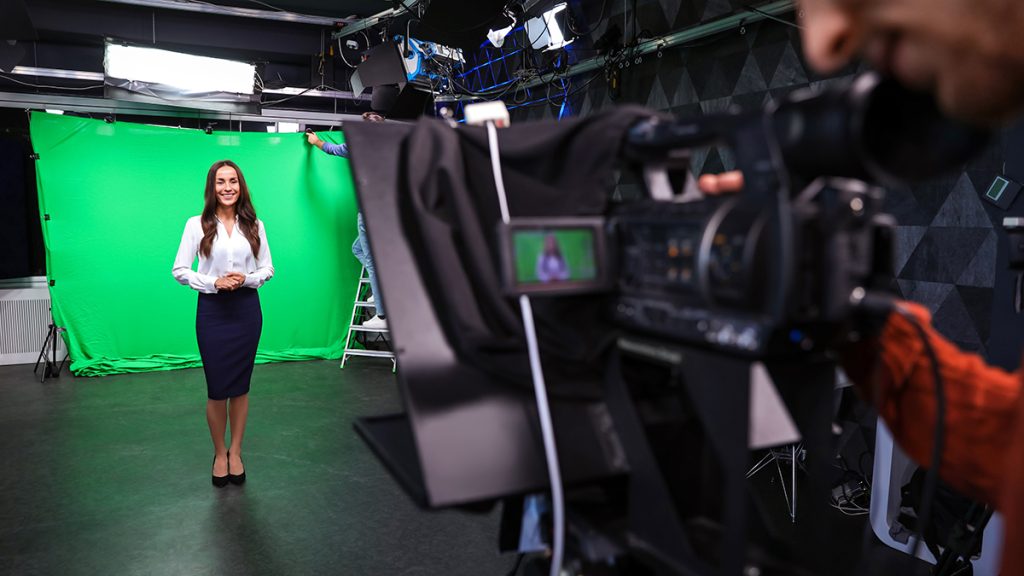
Tips for coaching on-air presenters
Journalists are challenging appearance and voice norms. Avoid blanket statements and broad assumptions when advising them on self-presentation
Elia Powers is an associate professor at Towson University where he teaches, among other things, podcasting and multimedia reporting.

Broadcast journalists have long had to negotiate their on-air self-presentation. That’s more recently been a focus for those in the news industry who regularly appear on podcasts and other online news programs. A growing share of journalists have to consider how they want to present themselves and how they will be received by audiences.
How do journalists who perform for audiences on television, radio and podcasts learn about expectations for self-presentation? Many do so through interactions with educators, performance advisers and newsroom leaders. These influential actors advise on some matters that are uncontroversial, like how to have a healthy voice and wear colors that show up best on camera. They also make more subjective evaluations about what looks appealing and sounds authoritative.
Many journalists from historically marginalized backgrounds have been advised to change their appearance or vocal delivery to avoid alienating audiences. As a result, they hid their accent, code switched, covered up their natural hair, toned down their mannerisms, avoided outfits that challenge traditional gender norms, and even changed or anglicized their name. Feelings of disempowerment led to disillusionment, prompting some journalists to switch jobs or pursue other professions. Some who stayed in the industry challenged restrictive self-presentation norms and spoke out about their experiences.
Interviews I conducted this fall suggest that young journalists may be less likely than ever before to feel the need to conform. Yet some still receive feedback that unnecessarily leads them to doubt whether they have a voice for radio or the right look for television. Anyone involved in hiring and promotion, performance reviews and coaching/advising can benefit from better understanding how their actions and guidance influence journalists’ careers and affect their self-image, and what meaningful actions can help reduce inequities.
Based on interviews I conducted for my new book, Performing the News: Identity, Authority, and the Myth of Neutrality, here are recommendations for how those who teach, train and manage journalists can have constructive conversations about self-presentation.
Journalism educators

Educators and former students agree that too much focus on self-presentation can be counterproductive but ignoring it is unhelpful because journalists need to be prepared for comments they might hear when they go onto the job market and enter newsrooms. Educators should give students candid feedback and also make clear that expectations differ within the industry. They should avoid blanket statements about what looks and sounds professional that may unintentionally dissuade students from pursuing on-air work.
When giving feedback, educators should be as specific as possible about how students can make improvements. This may require educators to learn more about speech and voice or engage experts to guest teach such topics. Conversations about voice and appearance that are explicitly or implicitly about race, gender or sexual orientation are particularly challenging to navigate and may be most productive if conducted privately.
When approaching such conversations, educators should determine what they feel comfortable discussing and frame their feedback carefully. Some consider comments about the body to be off limits; others only discuss physical features (e.g., a gap between teeth) if they sense it might hinder a student’s career. A journalism professor advises students on attire if what they wear is overly casual or revealing but does not comment on natural hairstyles or other forms of identity expression. He often starts conversations by telling students, “I respect the uniqueness in you.” Then he assumes the role of a recruiter, news director or agent, telling students, “The feedback I’m giving you reflects the industry standard, not my opinion.” His advice is that “you need to hear the feedback, but you may not have to internalize the feedback.”
A former journalist reminds mentees entering small broadcast markets with little diversity that “you offer a specific voice, a unique perspective, so you’re bringing something new to the table.” Then, she warns them: “When people bring you on because you’re a diverse hire, recognize that they’ll try to polish you up for a specific look and sound.” When educators warn students about what others may say, they should explain the likely rationale, state whether they consider this advice and rationale to be legitimate, and tell students how, if at all, expectations have evolved throughout the industry.
Educators justifiably advise young journalists to consider how much they are willing to compromise to advance. Said the former journalist, “If in your gut you’re moving too far away from who you are, you have to consider whether this is the right place to be.”
Performance advisers
Voice coaches, image consultants, media trainers and talent agents tend to support journalists’ decisions to present in ways that feel genuine while rightly offering pragmatic advice. A voice coach encourages clients to sound like themselves but warns that doing so “might limit job opportunities if you’re applying to stations that are run by people who aren’t as welcoming to different voices.” A consultant/agent tells journalists who are uncompromising about their hairstyle: “You have a right to do that, but you might have to find a place where [managers] don’t mind you wearing your hair that way.”
When giving feedback, advisers try to set aside personal preferences and instead position themselves as the average audience member. Yet the role of audience representative involves subjective assessments. Advisers should consider how their tastes — and assumptions about audience tastes — may affect their judgment.
During coaching sessions, advisers should ask journalists about their interests and goals before focusing on perceived problems. “I love the question, ‘Have you given thought to who you want to be behind the microphone?’” a former voice trainer said. He follows up with, “How are you feeling as you read this? Does it feel right to you; does it feel like you?”
A voice coach asks female journalists who have heard criticisms about their voice, “What do you want for yourself?” Another voice coach tells journalists to consider the source of the criticism. “If some listener wrote in, there are probably many others who think they sound great. If it’s a [complaint] they hear constantly and it’s in their head or if it’s feedback from their manager, I tell them, ‘Let’s figure this out.’”
Advisers should push newsroom leaders to clearly articulate their concerns. They should also help journalists communicate their interests and intentions to their managers so they can get specific feedback.
Newsroom leaders
News directors and other newsroom leaders set expectations for new hires, conduct performance reviews and suggest changes to journalists’ self-presentation. When meeting with new hires, managers should proactively identify their expectations and ask journalists how they wish to present themselves. If managers explain the reasoning behind their expectations and encourage feedback, employees may be less likely to feel targeted for disparate treatment.
Before asking journalists to change an aspect of their self-presentation, managers should ensure that the reasons for doing so are not based on unconfirmed assumptions about audiences, personal preferences or bias. Managers should ask themselves if the requested change in appearance or vocal delivery is intended to achieve adherence to job performance standards, identify each standard at issue and critically assess how necessary it is.
Managers also must determine if the journalist is a member of a protected civil rights group.
If so, asking for the change may be prohibited by law. This should involve consideration of whether the trait or attribute for which change is sought is strongly linked to membership in a protected group. If not legally prohibited, managers should weigh the legitimacy of the request for change against the significance of any adverse impact on the journalist.
Taking the steps outlined above should help managers and advisers have productive conversations and signal to journalists that they have some agency over their self-presentation.
Cite this article
Powers, Elia (2024, Nov. 7). Tips for coaching on-air presenters. Reynolds Journalism Institute. Retrieved from: https://rjionline.org/news/tips-for-coaching-on-air-presenters/
